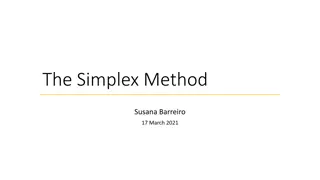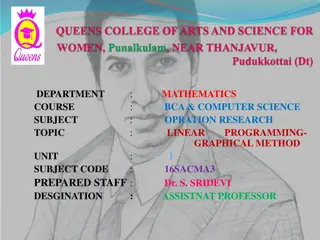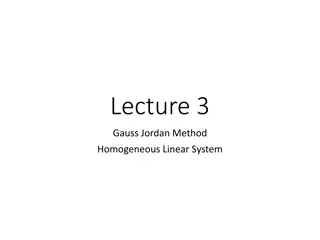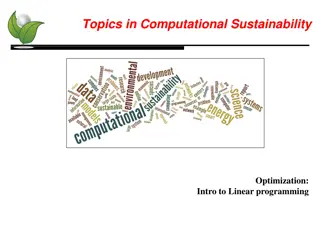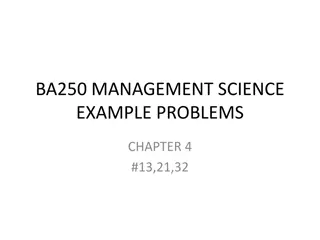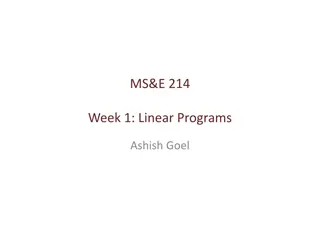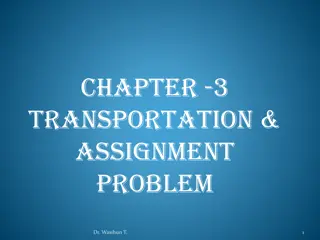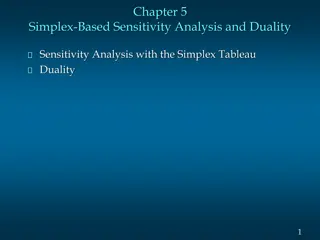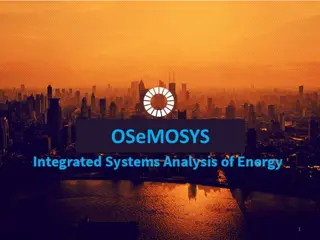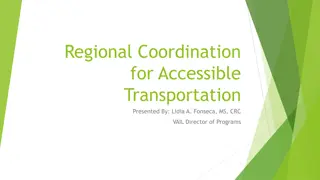Understanding the Transportation Method of Linear Programming
The Transportation Method of linear programming optimizes transportation routes by minimizing costs. It involves obtaining an initial feasible solution, testing for optimality, and utilizing methods like Stepping-stone and MODI to reach an optimal solution. Feasible solutions ensure demand and supply requirements are met, with objectives that include maximizing profit or minimizing shipping costs. Optimization in this context aims to choose the best distribution strategy.
Download Presentation

Please find below an Image/Link to download the presentation.
The content on the website is provided AS IS for your information and personal use only. It may not be sold, licensed, or shared on other websites without obtaining consent from the author. Download presentation by click this link. If you encounter any issues during the download, it is possible that the publisher has removed the file from their server.
E N D
Presentation Transcript
Transportation Method of Linear programming: Definition: The Transportation Method of linear programming is applied to the problems related to the study of the efficient transportation routes i.e. how efficiently the product from different sources of production is transported to the different destinations, such as the total transportation cost is minimum. Here origin means the place where the product is originated or manufactured for the ultimate sales while the places where the product is required to be sold is called destination. For solving the transportation problem, the following steps are to be systematically followed:
Obtaining the initial feasible solution, which means identifying the solution that satisfies the requirements of demand and supply. There are several methods through which the initial feasible solution can be obtained; these are: North-West corner method Lowest-Cost entry method / Matrix minima method Vogele s approximation method Note: It is to be ensured that the number of cells occupied should be equal to m+n-1, where m is the number of rows while n is the number of columns. Testing the optimality of the initial feasible solution. Once the feasible solution is obtained, the next step is to check whether it is optimum or not. There are two methods used for testing the optimality:
Stepping-stone Method Modified Distribution Method (MODI) The final step is to revise the solution until the optimum solution is obtained. The two most common objectives of transportation problem could be: i) maximize the profit of transporting n units of product to the destination y , ii) Minimize the cost of shipping n units of product to the destination y . ij x Feasible Solution- A set of non negative allocations which satisfies all the rim requirements is called a feasible solution to the transportation problems.
Optimization refers to the process of choosing elements considered to be the best from several alternatives that might be availed. As such, one has to solve problems with the aim of minimizing or maximizing a real function. This can be achieved via choosing values of integers or real variables from a specified set of values. The transportation problem is a special type of linear programming problem where the objective is to minimize the cost of distributing a product from a number of sources or origins to a number of destination.
Transportation Problem Suppose a commodity available at m origin or source Oi Where i varies from 1 to m and required at n destination Dj Where j varies from 1 to n . Assume ai is equal to amount of the commodity available at origin. bi amount of commodity required at destination Dj. Cij is equal to cost of transporting one unit of commodity from origin Oi to destination Dj .
Formulation ? ?=1 ? ? = ?=1 Where, ??? ??? Z=total cost of transportation ???=cost of transporting one unit of commodity ???=commodity transported form ith origin to jth origin
Short history People thought the transportation problem up early in the Second World War. It was used to determine how to move troops (located, for example, at training basis in different part of battleground in Europe and Asia. United State) to
Real life example You are the owner of a sports equipment sales chain. Your products are manufactured at three factories, and you have to deliver them customers After elaborating a survey, you found that the production capacity at each factory, the transportation cost to customers, and the demand amount at each customer are as shown in figure So, which of the transport routes would you choose to minimize the cost? to five
1.North-West Corner method. Definition: The North-West Corner Rule is a method adopted to compute the initial feasible solution of the transportation problem. The name North-west corner is given to this method because the basic variables are selected from the extreme left corner. The method consist of the following steps- Algorithm- Step-1 * Start with cell (1,1) and allocate it at minimum possible amount . Where = minimum of so that = or ( if = ) 11 x x x ( , ) 1b a 11 11 1 1 a 1 a 1 b 1 b
a b O Step-2* If the capacity of origin is exahausted but the but the reuirement of destination is still not satisfied . In this case move down to the cell (2,1) and allocate it maximum possible amount . Clearly 21 x 2 21 min ,b a x = b a O x min{ 12 a x = 1 1 1 D 1 x 1 11 D (ii) if ,the requirement at destination is satisfied but the capacity of origin is not completely exahausted.in this case ,move to the right hand cell (1,2) and allocate it maximum possible amount clearly- 12 1 1 1 1 , } x b Where- 1 11 2
a = b O (iii) if ,the capacity of origin is completely exahausted And same time requirements of destination is completely satisfied .in this case move down to the cell (2,1) and allocate =0 to the right cell and =0. 12 x 21 x 1 1 1 D 1 x or as the casemay be ,ass new north west 12 x Step-3* treat corner and proceed in the same manner as in step-2. Exahausting the origin capacities and satisfying the destination requirments one at a time move towards the lower right corner transportation table until all the rim requirements are satisfied. 21 NOTE- the initial BFS obtained by this method may be far away from the optimal solution because the cost are completely ignored in it.
Examples Ques-1.Determine the initial basic feasible solution to the following transportation problems? b b b b a 1 2 3 4 i 6 4 1 5 14 O 1 8 9 2 7 16 O 2 4 3 6 2 5 O 3 (total 35) 6 10 15 4 b j
Solution- First we allocate maximum possible amount to X11. D1 D2 D3 D4 Ai 6 4 1 5 O1 O2 (2) (14) O35 (1) (4) 14 / 8 (6) (8) 9 8 2 7 16 / 14 4 3 6 2 Bj 6 10 /2 15 / 1 4
Then- (6) (8) 6 4 9 2 (2) (14) 6 2 (1) (4) The answer is- 6 x 6 + 4 x 8 + 9 x 2 + 2 x 14 + 6 x 2 + 2 x 4 =128 //




